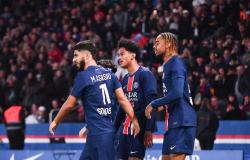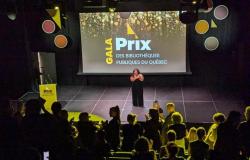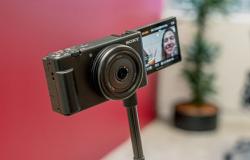This is a most original exhibition based on the chosen theme: trompe-l’oeil. The Marmottan-Monet museum brings together eighty of them, from its own collections or from Europe and the United States, ranging from the 16the to the present day. Born on the fringes of still life and vanity, the genre has its masters, particularly in the 17th century.e and 18e centuries: Cornelis Norbertus Gijsbrechts, Jean-François de La Motte, Guillaume Dominique Doncre, Louis-Léopold Boilly. All are illustrated in the “quodlibet”, or jumble: a wooden panel to which are attached, by a link or pins or wax, a whole little mess: letters, scores, playing cards, engravings, images stakes, brochures, coins, feathers, besicles…
Cornelis Norbertus Gijsbrechts (1649-after 1676?). Trompe-l’oeil, 1665. Oil on canvas. 59 x 56 cm. Paris, Marmottan Monet museum. © Marmottan Monet Museum / Studio Christian Baraja SLB
These choices of objects are explained by their familiar nature, which allows us to draw a “portrait” of the patron or the painter (the palette appears, in this case, or the self-portrait of the painter in a Doncre of 1785, in the form of an engraving next to a penknife, a pencil holder, a square… But these objects above all have the advantage of being flat or not very thick and, therefore, of lending themselves to the illusion of optically better than bulky objects We can clearly see the difference with a large vanity of Gijsbrechts which, deployed in space, does not belong to the genre itself. With a large trompe-l’oeil, 2 meters long,. La Motte undoubtedly reaches the limits of the genre, built on a jumble, it gains in thickness with a bust, a violin, a bottle and, on the right, widens on a bookcase. then gets lost.
It is to Louis-Léopold Boilly (1761-1845) that we owe the term “trompe-l’oeil”. He thus titled a painting exhibited at the Salon of 1800. His table top is famous. One of the coins displayed there bears the image of Napoleon Bonaparte; this would confirm the hypothesis that the work belonged to the Emperor. Boilly also liked to imitate prints and create accumulations of images (paintings, engravings, drawings). Like other specialists of the genre (Étienne Moulineuf), he sometimes presents them in a broken coaster… which is only a feint.
Louis Léopold Boilly (1761-1845) Trompe-l’oeil with coins, on the top of a pedestal table, circa 1808-1815. Oil painting on vellum and wood. Pedestal table 76 cm high, top 48 x 60 cm. Lille, Palace of Fine Arts. © Grand Palais Rmn (PBA, Lille) / Stéphane Maréchalle
The quodlibet is not all trompe l’oeil. Jean-Baptiste Oudry, painter of the dogs and hunts of Louis XV, painted a deer antler in a daring composition (Oudry was a daring painter of White duck on white backgroundin 1753). Anne Vallayer-Coster plays with sculpture, “painting” marble bas-reliefs (fauna, putti, etc.), two small monochrome paintings of great sensitivity. The imitation of white bas-reliefs intended to take place in a room, to decorate the architecture, had a certain success: such as the large “neo-classical” canvases by Jacob de Wit.

Henri Cadiou (1906-1989). The Tear, 1981. Oil on canvas. Private collection. © All rights reserved © ADAGP, Paris 2024
Au XXeit is the painters of the Trompe-l’oeil/Réalité group, led by Henri Cadiou (1906-1989), who breathe new life into a genre which, without having disappeared, had somewhat eclipsed itself. Cadiou signs The Tear (1981), packaging from which the Mona Lisa emerges. Pierre Ducordeau, Board on the go (1966). Certain modern works do not escape a certain dryness: The Reliquaryby Jacques Poirier; Postal Packageby Ton de Laat. Is this the effect of research too focused on hyperrealism? The quodlibets of the 17th centurye-XVIIIe show us that trompe l’oeil does not have to be photographic to create an illusion. Our senses do not require so much to be abused and reality is never so dry. Seen in this light, the trompe-l’oeil of contemporary art (Jadeby Daniel Firman, 2015), 100% realistic by means foreign to art, are not part of the continuity of a genre which mixed art and illusion by skillfully balancing both.
• Trompe l’oeil, from 1520 to the present day. Until March 2, 2025, Marmottan-Monet museum. 2, rue Louis-Boilly, 75016 Paris. Tuesday to Sunday, 10 a.m. to 6 p.m. Late night on Thursday until 9 p.m.
• The catalog (280 pages, 35 euros) will be in bookstores from October 31.
 Print, save or send this article
Print, save or send this article
![[EXPO] Trompe l’oeil, or when art meets illusion](https://euro.dayfr.com/temp/resized/medium_2024-10-20-8d5df1847f.jpg)
![[EXPO] Trompe l’oeil, or when art meets illusion](https://euro.dayfr.com/temp/resized/medium_2024-10-20-baa425bc69.jpg)
![[EXPO] Trompe l’oeil, or when art meets illusion](https://euro.dayfr.com/temp/resized/medium_2024-10-20-5071af20ae.jpg)
![[EXPO] Trompe l’oeil, or when art meets illusion](https://euro.dayfr.com/temp/resized/medium_2024-10-20-bd9c02584b.jpg)




